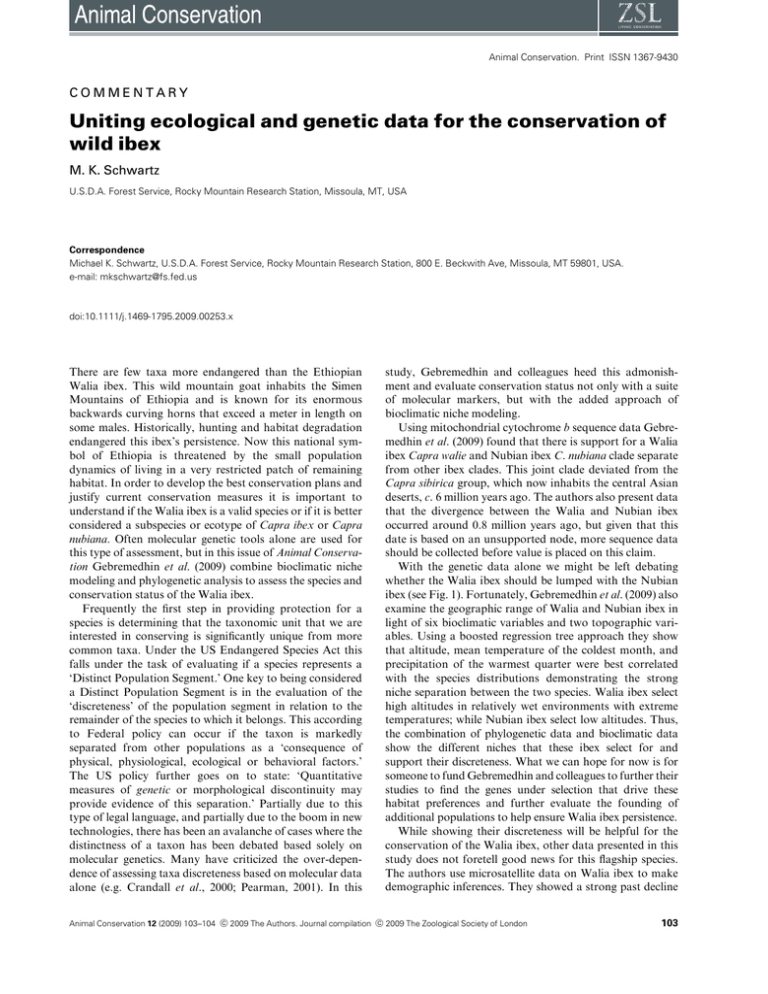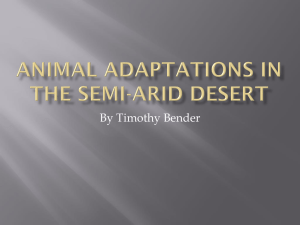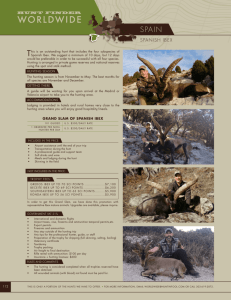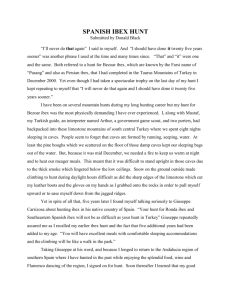Uniting ecological and genetic data for the conservation of wild ibex
advertisement

Animal Conservation. Print ISSN 1367-9430 COMMENTARY Uniting ecological and genetic data for the conservation of wild ibex M. K. Schwartz U.S.D.A. Forest Service, Rocky Mountain Research Station, Missoula, MT, USA Correspondence Michael K. Schwartz, U.S.D.A. Forest Service, Rocky Mountain Research Station, 800 E. Beckwith Ave, Missoula, MT 59801, USA. e-mail: mkschwartz@fs.fed.us doi:10.1111/j.1469-1795.2009.00253.x There are few taxa more endangered than the Ethiopian Walia ibex. This wild mountain goat inhabits the Simen Mountains of Ethiopia and is known for its enormous backwards curving horns that exceed a meter in length on some males. Historically, hunting and habitat degradation endangered this ibex’s persistence. Now this national symbol of Ethiopia is threatened by the small population dynamics of living in a very restricted patch of remaining habitat. In order to develop the best conservation plans and justify current conservation measures it is important to understand if the Walia ibex is a valid species or if it is better considered a subspecies or ecotype of Capra ibex or Capra nubiana. Often molecular genetic tools alone are used for this type of assessment, but in this issue of Animal Conservation Gebremedhin et al. (2009) combine bioclimatic niche modeling and phylogenetic analysis to assess the species and conservation status of the Walia ibex. Frequently the first step in providing protection for a species is determining that the taxonomic unit that we are interested in conserving is significantly unique from more common taxa. Under the US Endangered Species Act this falls under the task of evaluating if a species represents a ‘Distinct Population Segment.’ One key to being considered a Distinct Population Segment is in the evaluation of the ‘discreteness’ of the population segment in relation to the remainder of the species to which it belongs. This according to Federal policy can occur if the taxon is markedly separated from other populations as a ‘consequence of physical, physiological, ecological or behavioral factors.’ The US policy further goes on to state: ‘Quantitative measures of genetic or morphological discontinuity may provide evidence of this separation.’ Partially due to this type of legal language, and partially due to the boom in new technologies, there has been an avalanche of cases where the distinctness of a taxon has been debated based solely on molecular genetics. Many have criticized the over-dependence of assessing taxa discreteness based on molecular data alone (e.g. Crandall et al., 2000; Pearman, 2001). In this study, Gebremedhin and colleagues heed this admonishment and evaluate conservation status not only with a suite of molecular markers, but with the added approach of bioclimatic niche modeling. Using mitochondrial cytochrome b sequence data Gebremedhin et al. (2009) found that there is support for a Walia ibex Capra walie and Nubian ibex C. nubiana clade separate from other ibex clades. This joint clade deviated from the Capra sibirica group, which now inhabits the central Asian deserts, c. 6 million years ago. The authors also present data that the divergence between the Walia and Nubian ibex occurred around 0.8 million years ago, but given that this date is based on an unsupported node, more sequence data should be collected before value is placed on this claim. With the genetic data alone we might be left debating whether the Walia ibex should be lumped with the Nubian ibex (see Fig. 1). Fortunately, Gebremedhin et al. (2009) also examine the geographic range of Walia and Nubian ibex in light of six bioclimatic variables and two topographic variables. Using a boosted regression tree approach they show that altitude, mean temperature of the coldest month, and precipitation of the warmest quarter were best correlated with the species distributions demonstrating the strong niche separation between the two species. Walia ibex select high altitudes in relatively wet environments with extreme temperatures; while Nubian ibex select low altitudes. Thus, the combination of phylogenetic data and bioclimatic data show the different niches that these ibex select for and support their discreteness. What we can hope for now is for someone to fund Gebremedhin and colleagues to further their studies to find the genes under selection that drive these habitat preferences and further evaluate the founding of additional populations to help ensure Walia ibex persistence. While showing their discreteness will be helpful for the conservation of the Walia ibex, other data presented in this study does not foretell good news for this flagship species. The authors use microsatellite data on Walia ibex to make demographic inferences. They showed a strong past decline c 2009 The Authors. Journal compilation c 2009 The Zoological Society of London Animal Conservation 12 (2009) 103–104 103 Conservation of wild ibex M. K. Schwartz Evaluating units to conserve High support Northern spotted owl (Barred owl) Forest elephants (Savannah elephants) Eastern wolves (Grey wolves) Walia ibex (Nubian ibex) Phylogenetic distinctness Florida panther (Mountain lion) Low support Low support High support Environmental distinctness of c. 100-fold beginning between 10 000 and 30 000 years ago. This decline has lead to a serious reduction in genetic diversity. In fact six of the microsatellite markers used in this study were monomorphic, despite being highly variable in other Capra species. Fortunately, there is hope for the Walia ibex. Had this study suggested that Walia and Nubian ibex were not ecologically or genetically unique, it might have driven a stake through the heart of ibex conservation – analogous to the Hebrew story of Yael (‘Nubian ibex’ in Hebrew) who plunged a tent stake through the heart of Sisera, her mortal enemy. Yet armed with the new ecological and genetic data, conservation groups can now fight for the protection and recovery of this unique and endemic Ethiopian species. 104 Figure 1 A schematic showing the tandem use of ecological and phylogenetic data to evaluate the distinctiveness of taxa. The species at each point is the species of concern, whereas the species in parentheses is a more common species. In the case of the Walia ibex Capra walie it is through the combination of phylogenetic and environmental data that we can see the distinctiveness of each taxa. References Crandall, K.A., Bininda-Evans, O.R.P., Mace, G.M. & Wayne, R.K. (2000). Considering evolutionary processes in conservation biology. Trends Ecol. Evol. 15, 290–295. Gebremedhin, B., Ficetola, G.F., Naderi, S., Rezaei, H.-R., Maudet, C., Rioux, D., Luikart, G., Flagstad, Ø., Thuiller, W. & Taberlet, P. (2009). Combining genetic and ecological data to assess the conservation status of the endangered Ethiopian walia ibex. Anim. Conserv., 12, 89–100. Pearman, P.B. (2001). Conservation value of independently evolving units: sacred cow or testable hypothesis? Conserv. Biol. 15, 780–783. c 2009 The Authors. Journal compilation c 2009 The Zoological Society of London Animal Conservation 12 (2009) 103–104







